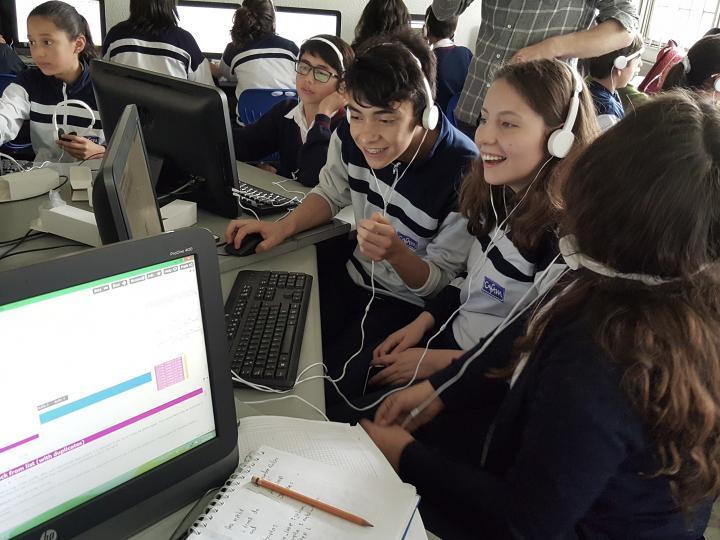Sounds around usBecome a better listener by strengthening your sensitivity to sound

Ready for action?
What
The possible connections with your curriculum
Who
The people who take up the teacher role
Where
The locations where learning takes place
With
The community stakeholders to collaborate with
Short abstract
Hearing is hugely important in our interaction with the world around us. The quantity and quality of sounds in our environment can directly impact on our health and wellbeing. This Learning Scenario will focus on sound, its properties and practical measures to control it. The activities will teach children to explore what sound is and examine its wave properties, such as reflection, dispersion, overlapping sounds from several sources, and sound absorption. Students will measure and analyse noise levels at different locations. They will explore ways to minimise noise around them. Students will pay particular attention to the energy of sound and then construct an acoustic screen to create a mini recording studio at school.
The students will carry out a series of experiments to produce sounds and vibrations, to identify what the sound is and how it is produced. They will explore the relationship between pitch and vibration frequency, as well as the relationship between loudness and the amplitude of vibrations.
In this unit students will explore the concepts of sound and silence. Students will notice that sounds can be ranked from the quietest to the loudest in terms of volume. However, the loudness of a sound is a subjective feeling. Instead of loudness, students will replace this with an objective and measurable physical quantity – sound intensity. Students will learn what ‘hearing threshold’ and ‘pain threshold’ are, and use apps to observe and measure sound intensity, volume and frequency.
Students will be visited by an expert to learn about the structure of the ear and how it works. They will then work together to find out about infrasound and ultrasound. They will research whether infrasound is safe for humans and why it is being researched by the military, before exploring the concept of echolocation by playing a game.
Students will work in separate groups to research what noise is, exploring whether all sounds noise, classifying types of noise, and measuring noise in decibels. They will use this research to teach each other about their respective topics. They will explore harmful effects of noise, and carry out an experiment to see if noise affects concentration.
Students will visit various places to test the level of sound and noise, using the decibel meter application on their smartphone. They can test the noise levels in the classroom, during breaktime, on a busy street, in a park, or at a construction site. They will write down the results and draw conclusions.
Students will learn about the Tacoma bridge collapse and find out what period, frequency and amplitude of vibrations are. Through designing their own experiments, students will learn about the phenomenon of mechanical resonance in everyday life. They will discuss the uses and dangers of this phenomenon.
Students will test the sound intensity at different distances from the source of a sound. Based on the results, they will create graphs of the relationship between distance and sound intensity.
Students will learn the importance of wave phenomena and their properties in understanding the essence of working with sounds. They will be divided into groups and conduct experiments with diffraction, a tuning fork in water, interference, and ‘Chinese whispers’. They will also study and reflect sound in different rooms.
Students will study sound-absorbing materials. They will calculate the sound intensity in a soundproof chamber with and without acoustic insulation, and at different frequencies. Based on the results, they will calculate the sound absorption coefficients for selected materials. Finally, they will design a house with soundproofing and make a model of it.
During this unit, the students will learn about the acoustic requirements of rooms for listening and recording music. They will learn about noise disturbances and how to minimise them. They will learn what an anechoic chamber is. They will experiment to determine the best arrangement of equipment (furniture and loudspeakers) and will pay attention to the wall, ceiling and floor surfaces.
Students will put together a presentation of their work for parents and science teachers from various schools in the city. They will demonstrate selected activities and present the results of their observations and research. They will organize an exhibition of their model soundproofed houses, share their knowledge about acoustic conditions in rooms for listening to music and for recording sounds, and show the acoustic screens they have designed and made. This event may take place as part of a Science Festival held at the school.
Teacher feedback
Aha moments
- The project is long, but it allows understanding of the sound phenomenon. There are many introductory lessons to learn the basics. It turns out that omitting some of them does not affect the implementation of the project.
Uh oh moments
General tips
- Test the operation of the equipment (decibel meters / smartphone applications) before you go out into the field.